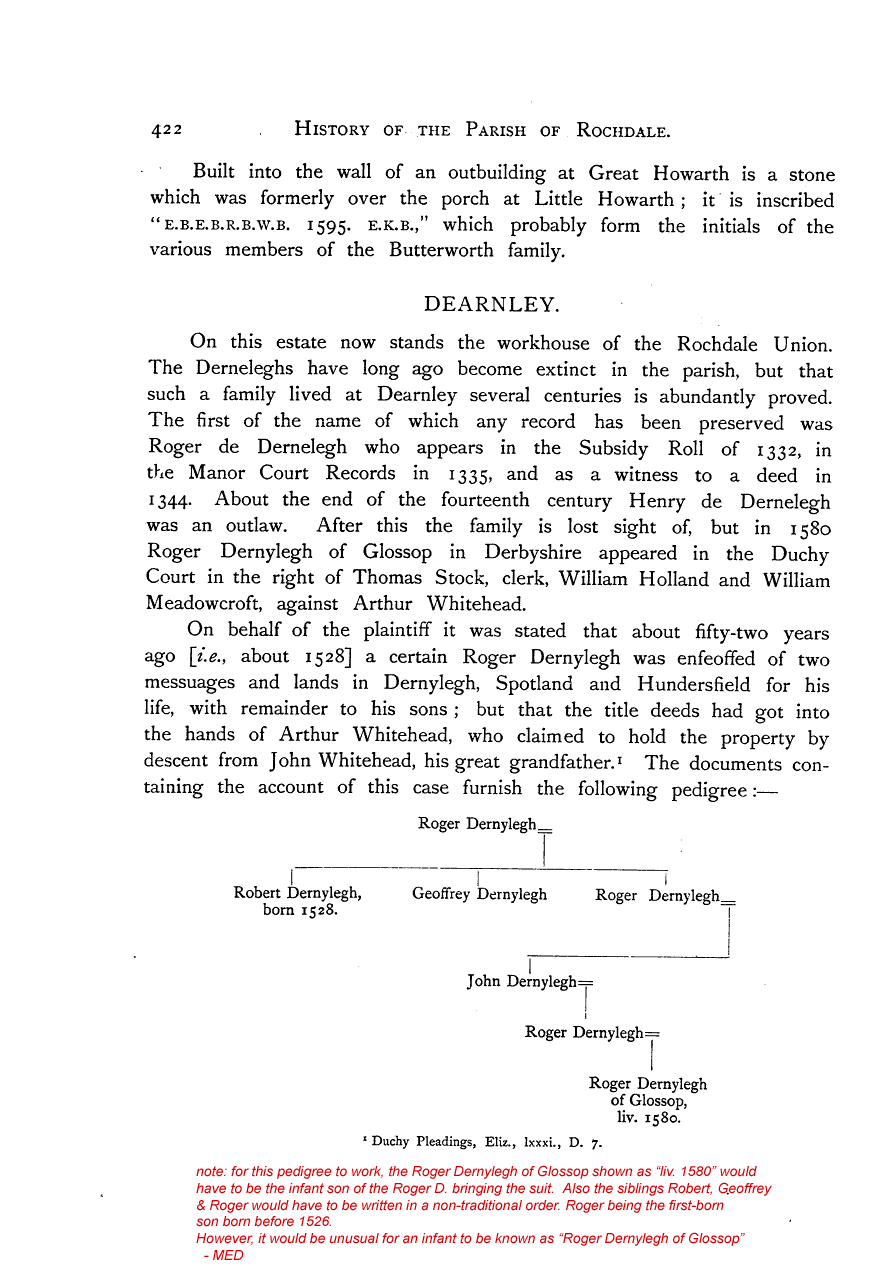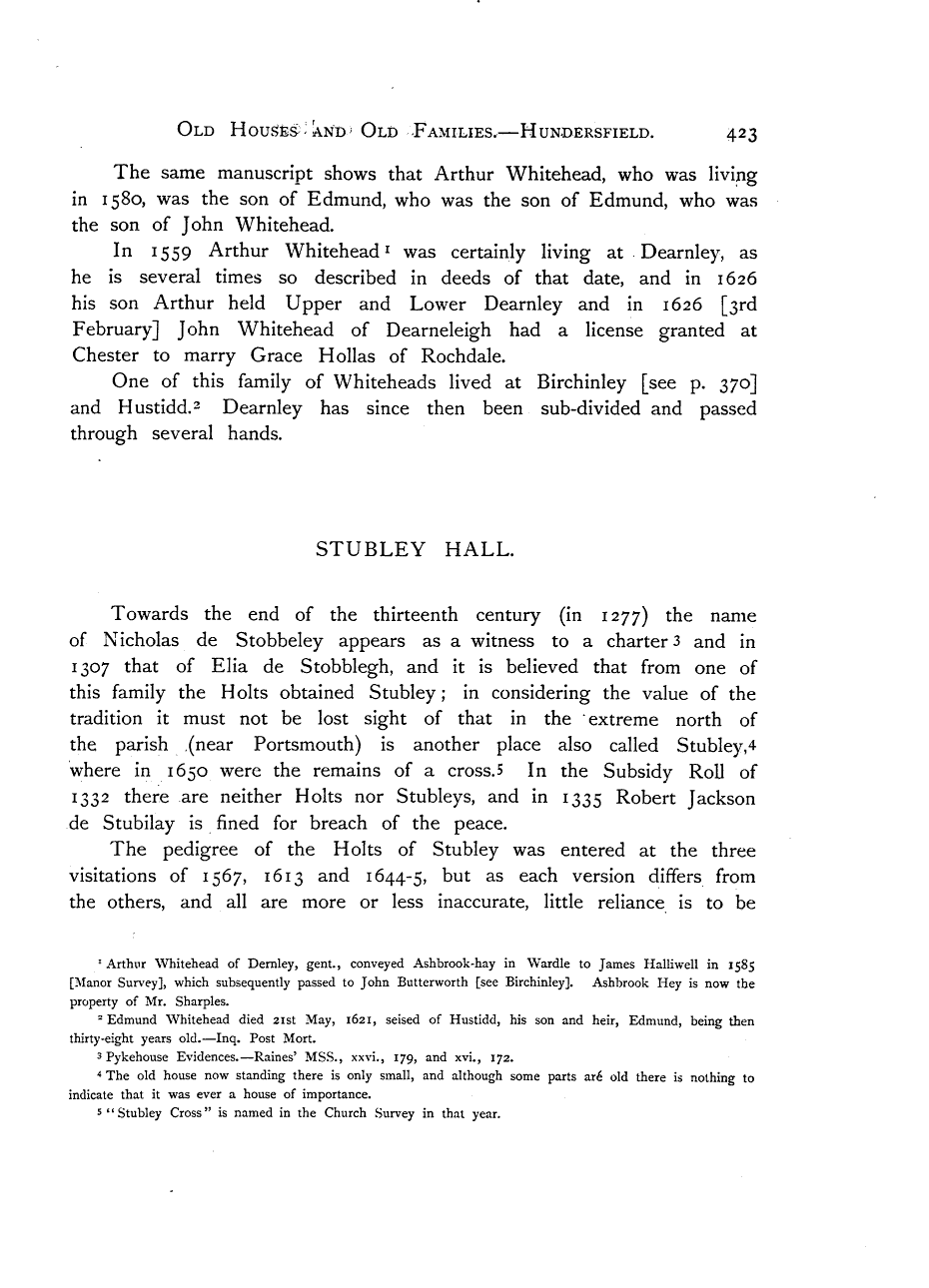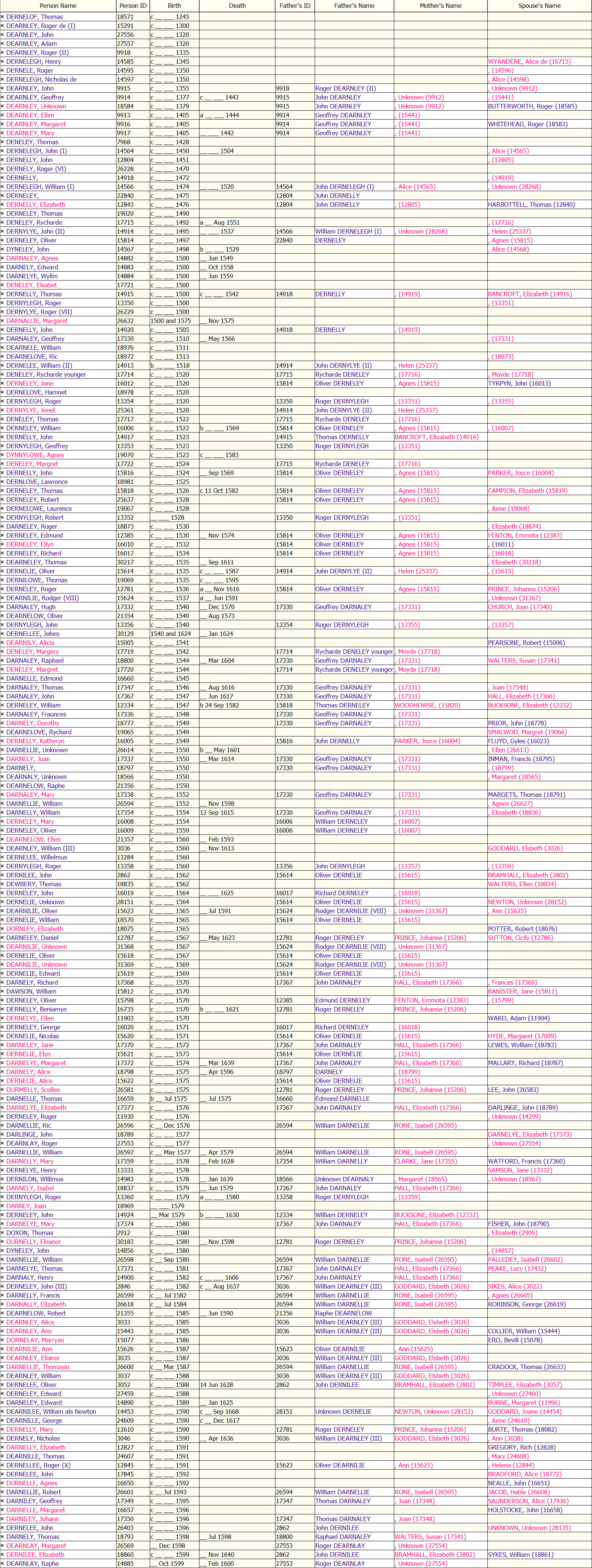Early Ds
1300s
|
The surname occurs in the 14th century; 'thus Roger de Dearnley contributed to the subsidy of 1332'; Exch. Lay Subs. (Rec. Soc. Lancs. and Ches.), At Michaelmas 1351 Richard son of William de Bury did not prosecute his suit against John del Dearnley and others respecting a tenement in Hundersfield; Duchy of Lanc. Assize R. I, m. 5 d. In 1360 Adam de Dearnley was a plaintiff, John de Dearnley being one of his pledges; ibid R. 8, m. 4 d; see also Dep. Keeper's Rep. xxxii, App. 342. |
|
Henry de Dernylegh (c.1350-) |
|
Outlawed for trespass ... |
|
| In 1400 it was stated that Henry de Dearnley had been outlawed in 1372 at the suit of Henry de Haworth for trespass, and that his land in Hundersfield had passed into the hands of the Ashton family; Pal. of Lanc. Misc. 1/9, m. 87-8; Dep. Keeper's Rep. xl, App. 536. |
|
| After the death of Robert de Buckley his widow Alice married Henry de Dearnley, an outlaw, whereupon the escheator took the estate into the king's hands, or, at least, the widow's third part. Alice died in Sept. 1423, and John de Buckley, son of Robert, in Oct. 1429, leaving a son and heir James; ibid. no. 496; Towneley MS. DD, no. 1483; Dep. Keeper's Rep. xl, App. 536. The lands were held of Sir Thomas Savile in socage. 'escheator': In feudal England, escheat referred to the situation where the tenant of a fief died without an heir or committed a felony. The fief reverted to the King's ownership for one year and one day, by right of primer seisin, after which it reverted to the original lord who had granted it. From the time of Henry III, the monarchy took particular interest in escheat as a source of revenue. From the 12th century onward, the Crown appointed escheators to manage escheats and report to the Exchequer, with one escheator per county established by the middle of the 14th century. Upon learning the death of a tenant, the escheator would hold an "inquisition post mortem" to learn if the king had any rights to the land. These were often preceded by a "writ of diem clausit extremum" issued by the king to seize the lands and hold the I.P.M. If there was any doubt, the escheator would seize the land and refer the case to Westminster where it would be settled, ensuring that not one day's revenue would be lost. This would be a source of concern with land owners when there were delays from Westminster. |
|
 |
| note: Hundersfield was an ancient ecclesiastical parish, created 1746 from the parish of Rochdale, in the Hundred of Salford, England. It straddled the historic county boundary between Lancashire and the West Riding of Yorkshire. There are written references to the parish dating back to 1202. Hundersfield lay on high moorland around Blackstone Edge, containing the settlements of Todmorden, Walsden, Littleborough, Wardle, Smallbridge and parts of Rochdale. |

In 1444 Roger Whitehead and Margaret his wife, together with Ellen Dearnley, recovered a moiety of two messuages, 40 acres of land. &c., in Hundersfield and Spotland, which Roger Dearnley had given to John Dearnley and his issue, and which after the death of John's son Geoffrey should descend to Margaret and Ellen, daughters of Geoffrey;
Pal. of Lanc. Plea R. 6, m. 12.
The same plaintiffs claimed the other moiety against Alexander son of Roger Butterworth; he replied that there was another daughter of Geoffrey, viz. Mary, still living at Newcastle on Tyne, but they said she had died at Chadderton in 1442; ibid. m. 12b The estate was claimed as late as 1580 by a Roger Dearnley against Arthur Whitehead; (see below) see Fishwick, op. cit. 442 (quoting Duchy of Lanc. Plead. Eliz. lxxxi, D. 7)Moiety - one of two (approximately) equal parts Messuage -a dwelling house and its adjacent buildings and the adjacent land used by the household.
"History of the Parish of Rochdale" by Henry Fishwick

| Some thoughts regarding the dates on Fishwick's Dernylegh tree (above). - JAD "In 1580 ... On behalf of the plaintiff it was stated that about fifty-two years ago [i.e., about 1528] a certain Roger Dernylegh was ..." Perhaps: "about 52 years ago" = circa lii years ago = c.lii years ago = clii years ago = one hundred and fifty-two years ago If so, the first listed Roger Dernylegh would then be "enfeoffed of" the lands closer to 1428. Assuming a 28 yr generation gap, the descendents of Roger (born about 1408) would then be: Roger Dernylegh born about 1446 John Dernylegh born about 1474 Roger Dernylegh born about 1502 Roger Dernylegh of Glossop, liv 1580; therefore born about 1530. |

| Problems with the above pedigree for Roger of Glossop include both the dates and the possibility of missing generations. The property in dispute in 1580 appears to have previously been in dispute in 1444 (see notes for John Dearnley 1355 (#9915) and his descendants) and 1504-15 (see notes for Roger Dernely 1470 (#26228). An attempt to provide linkage between the various people involved in these three recorded disputes is given in the table below. |
Table providing an alternative pedigree linking the disputes of 1444, 1504-15 and 1580 - a work in progress |
|||||||
gen. |
name |
born |
known to be alive in: |
name |
born |
believed to be alive in: |
comments |
| 1 | Roger Dearnley (II) | c1325 | Possibly a son of Roger (I) known to be alive in 1332. | ||||
| 2 | John Dearnley (0) | c1355 | 1384 | Named in 1444 dispute as son of Roger (II), but missing from Fishwick's pedigree |
|||
Elder son |
Younger son |
John (0)'s sons may be half-brothers. |
|||||
| 3 | Geoffrey Dearnley | c1377 | 1397 | Roger Dearnley (IV) | c1410 | 1444 | Roger (IV) (& a 3rd brother Robert) only known from Fishwick's pedigree. |
Descendants of the above Geoffrey |
Descendants of the above Roger (IV) |
||||||
| 4 | Margaret (Whitehead) and sister Ellen | c1405 | 1444 | John Dearnley (I) | c1450 | Various assumptions being made on father/son relationships. | |
| 5 | John Whitehead | c1440 | - | Roger Dearnley (VI) | c1475 | 1504-15 | Court case 1504-15. |
| 6 | Edmund Whitehead | c1470 | - | Roger Dearnley (VII) | c1500 | 1537 | Roger (VII) named in will of John (II). |
| 7 | Edmund Whitehead | c1500 | - | Roger of Glossop (VIII) | c1530 | 1580 1586 1591 |
Court case of 1580. Witness to a will in Glossop in 1586. Named in son Oliver's will of 1591. |
| 8 | Arthur Whitehead | c1525 | 1580 | ||||
| Notes: | |
| i | All birth years are estimates. |
| ii | Numbering systems for the various Rogers and Johns as used elsewhere on the website - see Roger (II) (#9918) and John (I) (#14564). |
| iii | Compared with Fishwick's pedigree, the above table contains an additional two generations for the Dearnleys (generation 2 and generation 5 or 6). |
| J.A.D. 2017 |
 |
Suggested Generations of Roger D. The generation numbers are based on the Rogers known in November 2016. |
|||||
gen. |
name |
born |
known dates |
abode |
comment |
| I | Roger de Dearnley | c1300 | Alive 1332 | Contributed to subsidy of 1332. | |
| II | Roger Dearnley perhaps also Roger Dernele |
c1335 | The Roger Dearnley named in the 1444 court case with son John. On the 1379 West Riding Subsidy roll. |
||
| (III) | John the father of Geoffrey, named in 1444 case, is in this generation. |
||||
| IV | (Unnamed Dearnley maybe a Roger) |
1444 court case | Assuming there was a Dearnley involved in the 1444 case, a younger brother of Geoffrey, from whom the Whiteheads recovered the property. |
||
| (V) | John (I) 1450-1504, wife Alice, is in this generation. |
||||
| VI | Roger Dernely | c1470 | Court case 1504-15 | Was Roger VI the eldest son of John (I) with younger half-brother William I? | |
| VII | Roger Dernylye | c1500 | John (II)'s will 1537 | 'of ye Hyll' | Roger VII was to counsel John II's children. (Based on the above suggestion for Roger VI, Roger VII and John II would be half-cousins.) |
| VIII | Roger Dearnley Roddger Dernelie Rodger Dearnilie |
c1537 | Court case 1580. Named in 1586 will. Son's will 1591. |
'of ye Hyll' | Named in 1586 will of Oliver of the Blackshaw. (2nd cousins?) |
| (IX) | Oliver of Dinting in this generation. | ||||
| X | Roger Dernellee | c1591 | of Hilltoppe' | Moved from Dinting to Whitfield. | |
Above table edited in 2019.
- Janet Davies
 |
Key to Padfield+ Dearnleys: The generation numbers are based on individuals known in 2016. |
||
| John (I) | c.1450-, property in Holme, married to Alice | see John Dernelegh (I) |
| William (I) | son of above; c.1474- | see William Dernelee (I) |
| John (II) of Padfield | c.1495-, brother or son of William (I) | see John Dernylye (II) |
| William (II) of Padfield | b. before 1518, son of John (II) | see William Dernelee (II) |
| William (III) of Padfield | c.1560-, likely descendant of William (II) (son or grandson), married Elizabeth |
see William Dearnley (III) |
| John (III) of Padfield | c.1582-, son of William (III), married to Ann then Alice | see John Derneley (III) |
| William (IV) of Mottram & Padfield |
c.1604-, married to Marie Redditch | see William Dearneley (IV). |
 |
Early Dearnaleys in Dinting and Padfield By the early sixteenth century, there were at least two branches of the Dearnaley family in Glossop, one that settled in Dinting and one that settled in Padfield. The Dinting branch is assumed to be the senior branch (as evidenced by the court cases brought by members of this branch re property at Dearnley, Lancashire). The Padfield branch expanded into other areas around Glossop (Blackshaw, Hadfield etc) from the first half of the sixteenth century onwards. The Dinting family is less well documented and does not seem to have expanded locally in the same way. Either this branch had less sons, or the sons migrated away from the area. With reference to the Dinting branch, the placename Hilltop appears on modern OS maps, in Higher Dinting, about a kilometre south of Padfield. Although not recorded until 1561, this could be the location at which the Dearnaley family first settled after the move from Lancashire to Derbyshire. The table below provides dates for documentary evidence of the two branches. |
||||
| decade | date | Dinting branch | Padfield branch | comment |
| 1500s | ||||
| 1 | 1504 | Roger (VI) - petition re property in Dearnley, Lancashire. | William (I) paid heriot on death of his father and mother John (I) and Alice, for property in Yorkshire | Note both events dated 1504. ?Both sons of John (I)? No indication of current abode for Roger (VI) or William (I). |
| 2 | ||||
| 3 | ||||
| 4 | 1537 | Roger (VII) named in will of John (II) of Padfield, but Roger's abode not given | Will of John (II), mentioning Padfield and Blackshaw. Son William (II) paid heriot on death of father John (II) (for Yorkshire property) |
First mention of Padfield. Roger (VII) 'to counsel' John's children. |
| 5 | ||||
| 6 | ||||
| 7 | 1561 | Roger Dernelle off ye hyll named in will of Wyllm Newton. Roger (VII) or (VIII). |
First reference to Dinting. | |
| 8 | ||||
| 9 | 1585 1586 |
Roger (VIII) witness to will of Oliver of the Blackshaw son of John (II). | William (II) of Padfield named in property transaction. | ? Was will of Oliver of the Blackshaw the last joint mention of the 2 branches? |
| 10 | 1591 1599 |
1591 will: Oliver of Dinting names father Roger (VIII) | 1599: William (II) and William (III) both of Padfield named in will of Nicholas Hadfielde. | |
| 1600s | ||||
| 1 | ||||
| 2 | Will of William (III) of Padfield. | John (III) inherits property from grandfather and Nicholas inherits his father's property - both Padfield | ||
| 3 | 1626 | Roger Dearnilie of the Hilltoppe (Roger (X)) named in will of Anne Newton | Baptisms of Roger (X)'s children in 1620s give abode as Dinting. | |
| 4 | 1632 | Roger (X) in Whitfield | ||
| Later dates |
||||
| 1685 | A later Dearneley at Hilltoppe | Burial of Joane Dearneley widow of Hilltoppe (husband's name unknown.) |
||
| 1705 | Will of John (IV) of Padfield | Last Dearnaley at Padfield. | ||
JAD 2020

| The Dearnleys: the principal sources in the different centuries | |||||
| century | sources | dates | examples | TMG # | comments |
| 14th | Subsidy of 1332 Manor Court Records Property deeds Grants, quitclaims and fines Patent Rolls |
1332 1335 1344 1382 1397 |
Roger de Dearnley (I) ditto ditto Henry Dernelegh Geoffrey Dearnley |
15291 14585 9914 |
Earliest Dearnley reference to date. The only known outlaw in the family. Earliest written reference to a Dearnley father-son relationship. |
| 15th | Court cases | 1444 | Margaret Dearnley | 9916 | The first recorded inheritance dispute. |
| 16th | Manorial rolls Court proceedings Wills Parish records |
1504 1504 1537 1566 |
William Dernelegh (I) Roger Dernely (VI) John Dernylye (II) - |
14566 26228 14914 - |
First of many records re Dearnley property in Holme, Yorkshire. See also 1444 and 1580 court cases. Earliest Dearnley will. Marriage in Ecclesfield: first parish record for a Dearnley? |
| 17th | Parish records Wills Hearth Tax |
1620 1651 1662-70 |
Anna Dernellee William Dearneley (IV) John Dearnely (V) |
14441 3023 3025 |
First Glossop parish record for a Dearnley. William IV is in the largest of the current family trees. John's "3 hearth" property was the largest property in Padfield. |
| 18th | Parish records Wills Land Tax |
- 1743 1798 |
- James Dearneley Amos Dearnaley |
- 3306 132 |
- One of the large number of Dearnleys in the Holme Valley. Missing baptism records - where was Amos born? |
| 19th | Civil registration of bmds Censuses Personal documents Memorial inscriptions |
from 1837 from 1841 1848 1860s |
- - Ralph Dearnaley Samuel Dearnaley |
- - 14165 5053 |
Printed baptism registers were introduced circa 1812 - Log of voyage from England to America. Memorial plaque for Samuel & Mary and 8 children at Woodhead. |
| 20th | Civil registration of bmds Censuses The 1939 Register |
from 1837 up to 1911* 1939 |
FamilySearch; UK BDM Search; FreeBMD & others. |
||
* The 1921 census is scheluded for release online in January 2022
JAD

|
All early Ds currently in database c.1245-c.1599 updated July 2020 |
 |
| Trees & any Dearnley stuff welcome please email Mark please note: with the web constantly changing, some source URL's may have moved. 'Good Hunting' |